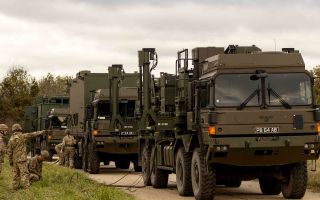Detailed analysis of Russia's Oreshnik hypersonic missile strike on Ukraine
Russia says it used a hypersonic missile during the Dnipro factory attack on 21 November.
It's thought to be a variant of the RS-26 missile Rubezh - a shortened version of the RS-24 Yars missile (Topol-MR).
Capable of being ground launched from a transporter-erector-launcher, or TEL for short, the RS-26 is thought to have come from the Kapustin Yar training ground in Astrakhan Oblast – a distance of 510 miles between launch site and the target.
The US Department of Defence has confirmed it was not an intercontinental ballistic missile, or ICBM, downgrading it to an Intermediate Range Ballistic Missile, or IRBM for short.
The missile was identified by Russian President Vladimir Putin as an Oreshnik medium-range non-nuclear hypersonic ballistic missile.
Normally ballistic missiles travel in an arc from their launch point into space and then down through the atmosphere onto the target.
Hypersonic weapons are different. In 2018 the Russians claimed they had developed a hypersonic glide vehicle called Avangard which they described as a "gliding block".
This sort of missile would be launched ballistically upwards, but then release the glide vehicle, which would skim the atmosphere on the edge of space. It can make turns to avoid high altitude interceptor missiles.
It's believed a version of the Avangard system can be carried on the RS-26 missile which Oreshnik was developed from.
Multiple sub-munitions
In the videos of the missile strike in the Ukrainian city of Dnipro you can see the missile has released six sub-munitions, which then release six smaller sub-munitions - a total of 36 separate impacts are the result.
The munitions can be seen lighting up the clouds as they streak down. They also appear to be glowing, possibly from the heat of atmospheric entry which would have taken less than half a minute to reach the ground from space.
It's possible these munitions contained no explosive and were pure kinetic energy weapons. The energy delivered by projectiles travelling at Mach 10 or 7,000 mph would be very high.
The target was the PA Pivdenmash factory in Dnipro. It makes rocket motors and other space technology products.
Dnipro, known previously as Dnipropetrovsk, was a centre of Soviet Cold War ballistic missile production and was nicknamed Rocket City.
The Ukrainians are unlikely to reveal how much damage was caused to the target factory. It's possible it was not even hit at all.
Mr Putin stated that it was a combined weapons strike, explaining the explosions caught on security cameras following the Oreshnik strike which is possibly the arrival of Kinzhal or KH-101 missiles.
Western military analysts are continuing to study the missile flight characteristics and target effects to find ways to counter this system in the future.
For the Russians, the attack demonstrated a response to the Ukrainian use of Atacms and Storm Shadow missiles.
It also provided an opportunity to test their latest missile system in combat.







